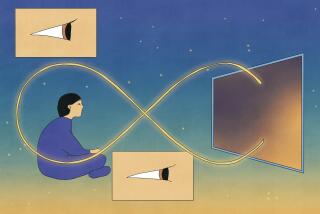As TV shows go online, networks try to adapt ads
The venerable 30-second television spot has been declared dead many times. People such as Beth Jeter could finally kill it off.
Jeter watches “Lost” and “Grey’s Anatomy” at ABC’s website on her laptop. She ignores the ads. When they’re on, she checks her e-mail.
“For some reason,” said Jeter, a 25-year-old government worker in Washington, “it’s easier to get away from the ads when they’re on your computer.”
With the personal computer replacing the television set for a growing number of Americans, the 30-second spot, along with most conventional TV advertising, is under pressure.
For years, people have been able to circumvent TV ads with digital video recorders, but that requires some effort. There are much easier opportunities for ad-avoiding multitasking at the click of a mouse, which is why the networks are experimenting with a mix of alternative formats for online promotional breaks -- including having none at all.
Advertisers are filling online ad time in ways they can’t on TV, with interactive videos and competitions. For a campaign for Florida Citrus, the Dallas-based agency Richards Group created a “flu or false” health quiz and a game set in a maze whose walls were contaminated with germs. The games had several levels, the idea being that once viewers started playing they’d be hooked and would stay with it for a lot longer than 30 seconds, going back to the TV show later.
Agency research showed that in many cases, people did just that, underscoring a point often made by Joseph Jaffe, author of “Life After the 30-Second Spot.”
“At the end of the day, why would anybody of sane mind and body sit through a commercial?” said Jaffe, whose book was published in 2005. Online advertisers stand a chance of keeping an audience’s attention, he said, by making commercials that don’t appear to be commercials.
The most effective ones are, of course, like programs themselves, said Rick Corteville, executive director of media at San Francisco-based digital marketing agency Organic, which created an interactive video ad for the 2007 Jeep Patriot.
The spot is meant to draw people in. The Web, Corteville said, is “more of a pull medium than a pure broadcast push.”
Called “The Way Beyond Trail,” the video is about three characters searching for a buried treasure -- doing so, of course, in a Jeep Patriot. When the video pauses, the online viewer chooses what happens next to the characters. A segment of the video played on auto enthusiast websites, Yahoo and MSN, and eventually it was given its own website.
Real Time Content, a new British firm that calls itself an adaptive media company, tells prospective clients that it can make as many as 600 versions of one commercial for different demographics. With just a bit of information about each person watching a TV show on the Web, Real Time’s platform can tailor audio and video, Chief Executive Naj Kidwai said.
A mother with small children would see a clip showing how easy it is to put a stroller in the back of the Brand X car whereas a single young woman would see one about how much fun the Brand X is to drive.
On ABC.com, the made-for-TV commercial has all but disappeared from the media player, which won an Interactive Television Emmy last year. The network calls promotional breaks in an online show “ad pods” or “containers” because advertisers can fill them with “experiences” such as games, clips or trivia contests, said Rick Mandler, vice president for digital and new media at ABC.
At NBC, Peter Naylor, senior vice president of digital sales, calls online commercials super-spots.
For its part, Fox is toying with taking away the stops and starts of a commercial break, said Michael Barrett, chief revenue officer for Fox Interactive Media. An ad might instead appear as a logo as a show plays or as a ticker scrolling across the bottom of the screen.
The networks say that advertisers get more for their money online. A January study from research firm Millward Brown found that 82% of people remembered an ad or brand they saw online, whereas only 54% of TV watchers did.
Advertisers pay a premium for online promotions, in some cases as much per viewer as they do on prime-time TV. But relatively few people, at least for now, watch TV shows online.
In fact, it’s not clear exactly how many do. The Nielsen rating service is only now beginning to measure audiences watching online. It aims to have data available later this year.
Research firm EMarketer anticipates that $2.9 billion will be spent on online video advertising in 2010, up from $775 million this year. By comparison, advertisers committed to spend $93 billion for network TV airtime during the recent so-called upfront negotiations.
The gap will no doubt close over time, as more Americans switch from the TV to the PC. But there are limits to what a viewer will tolerate.
Marin Smith, a 28-year-old Brooklyn resident, watches NBC’s “30 Rock” and ABC’s “Grey’s Anatomy” on her computer, happy to endure a few short breaks to avoid the long commercials that must be slogged through on a television if there isn’t a DVR handy.
What if she could watch TV on a PC with no breaks at all, but with ads scrolling continuously across the bottom of the screen during a show?
“That,” she said, “would be really annoying.”
--
--
Begin text of infobox
A brief history of TV advertising
The first television advertisement in the United States, for Bulova Watch Co., premiered before a baseball game in 1941. It lasted 20 seconds.
U.S. ad spending on TV commercials increased from $12 million in 1949 to $158 million 1952.
In the 1950s and 1960s, television commercials lasted one minute on average.
Advertisers embraced 30-second commercials in the early 1970s as they tried to keep viewers’ attention while packing many ads into the breaks in the shows.
In May of this year, 30-second spots accounted for 60.7% of the 9,220 commercials that appeared on the four major broadcast networks during prime time.
--
Sources: Kenneth Wilbur of USC Marshall School of Business and Mark Tungate, author of “Adland: A Global History of Advertising.”



